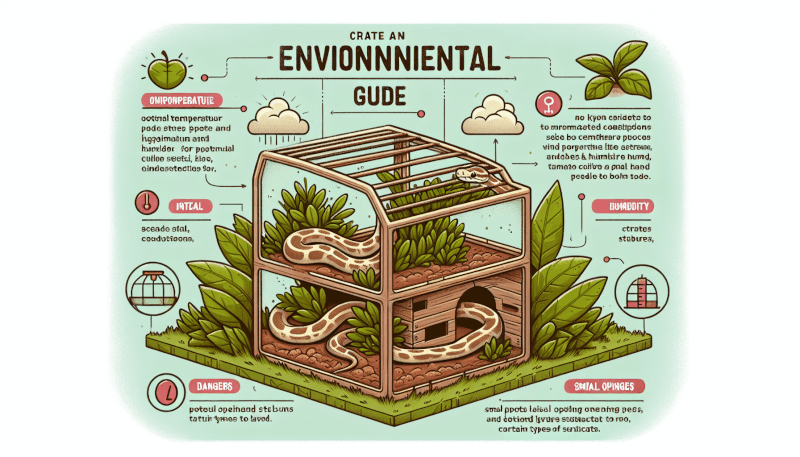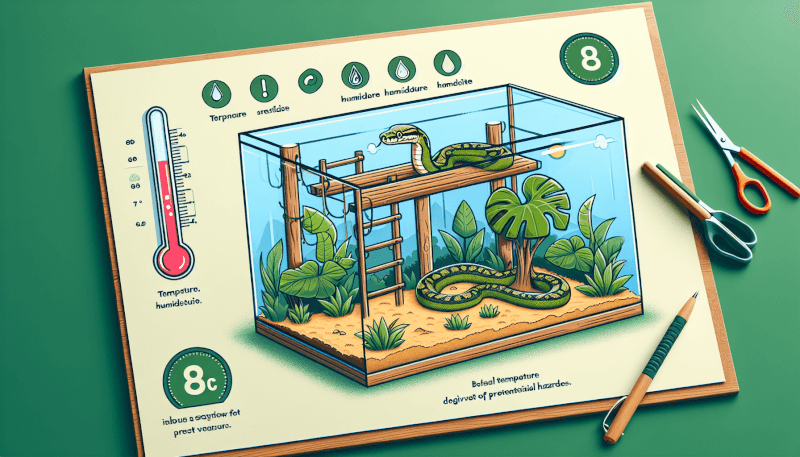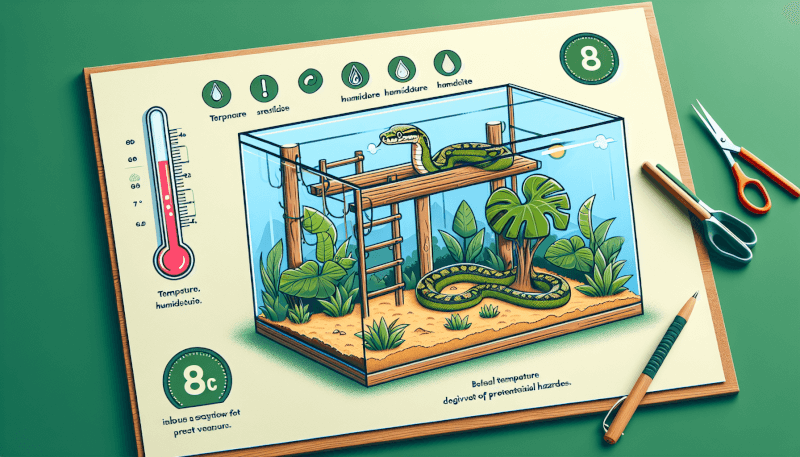In the Beginner’s Guide to Creating a Safe Environment for Pet Snakes, you will discover essential tips and guidelines for ensuring the well-being of your slimy friend. From the proper temperature and humidity levels to suitable enclosure setup and habitats, this article will equip you with all the necessary information to create a comfortable and safe living space for your pet snake. Whether you have just welcomed a new slithery companion into your home or are considering getting one, this guide will help you provide the ideal environment for a happy and healthy snake. So, let’s get started on this exciting journey of snake ownership!

Choosing the Right Enclosure
Choosing the Size of the Enclosure
When it comes to choosing the right enclosure for your pet snake, size is of utmost importance. Snakes need enough space to move around and stretch out comfortably. A general rule of thumb is to provide an enclosure that is at least as long as the snake’s body length. This gives them enough room to move and explore their surroundings. Remember, a cramped enclosure can cause stress and negatively impact their health, so choose the size of the enclosure accordingly.
Selecting the Type of Enclosure
There are different types of enclosures available for pet snakes, including glass terrariums, plastic tubs, and wooden cages. Glass terrariums are popular because they provide a clear view of your snake and allow for easy maintenance. Plastic tubs, on the other hand, are lightweight and can be easily stacked, making them suitable for multiple snakes. Wooden cages provide excellent insulation and can be customized to meet your snake’s specific needs. Consider factors like your snake’s size, habitat preferences, and your own personal preferences when selecting the type of enclosure.
Providing Adequate Ventilation
Proper ventilation is crucial for maintaining a healthy and comfortable environment for your pet snake. Ensure that the enclosure has adequate airflow to prevent the buildup of stale air and excessive humidity. This can be achieved by using fine mesh screens or vents on the sides or top of the enclosure. Good ventilation helps regulate temperature and prevents the growth of harmful bacteria or molds.
Setting Up the Enclosure
Choosing the Substrate
Selecting the right substrate is essential for your pet snake’s comfort and overall well-being. Substrate options include aspen shavings, cypress mulch, reptile carpet, and paper towels. Avoid using substrates like pine or cedar, as they can release harmful chemicals. The substrate should be easy to clean and maintain, and it should provide a comfortable surface for your snake to move around on.
Adding Hiding Spots
Snakes are naturally shy creatures that require hiding spots to feel secure. Provide at least one hide on the cooler side of the enclosure and one on the warmer side. Hides can be in the form of commercially available shelters, half logs, or even upside-down flower pots. Make sure the hides are appropriately sized, allowing the snake to fit snugly inside. These hiding spots give your snake a sense of security and privacy, reducing stress levels and promoting natural behaviors.
Including Climbable Branches or Platforms
Many snake species are adept climbers and enjoy exploring their environment vertically. Providing climbable branches or platforms inside the enclosure can enhance your snake’s overall well-being. These branches or platforms should be sturdy enough to support the snake’s weight and should be securely positioned to prevent any accidents. Adding vertical elements to the enclosure allows your snake to exercise and display natural behaviors, making their living space more enriching.

Maintaining Optimal Temperature and Humidity
Understanding Temperature Requirements
Maintaining the right temperature range is vital for your snake’s health and proper physiological functioning. Most snakes require a temperature gradient within their enclosure, with one side being warmer and the other side cooler. The warm side should be between 85-90°F (29-32°C), while the cool side should be around 75-80°F (24-27°C). Use temperature-regulating equipment like heating pads, heat lamps, or ceramic heaters to achieve and maintain the appropriate temperature range.
Using Heat Sources
To provide the necessary warmth for your snake, various heat sources can be utilized. Under-tank heating pads or heat tape can be placed on one side of the enclosure to create a warm spot. Heat lamps can also be used, but be cautious of potential burns, especially if the enclosure is made of glass. Ceramic heaters are another option, as they emit heat without producing light. Whichever heat source you choose, ensure it is properly installed and monitored to prevent overheating or accidental burns.
Monitoring and Adjusting Humidity Levels
Proper humidity levels are essential for your snake’s respiratory health and shedding process. Different snake species have varying humidity requirements, so it’s crucial to research your specific snake’s needs. Using a hygrometer, monitor the humidity levels within the enclosure regularly. If the humidity is too low, you can raise it by providing a larger water bowl or using a reptile-specific humidifier. On the other hand, if the humidity is too high, you can increase ventilation or decrease the amount of water in the enclosure.
Providing Proper Lighting
Choosing the Right Light Bulbs
While snakes do not require UVB lighting like some reptiles, providing a light source that mimics natural daylight is still important. Choose a light bulb with the appropriate wattage for the size of your enclosure. Incandescent bulbs or LED bulbs can be used to provide a natural-looking light that also promotes a healthy day-night cycle for your snake. Avoid using colored bulbs, as they may interfere with your snake’s natural behavior and vision.
Setting Up a Lighting Schedule
Establishing a consistent lighting schedule is beneficial for your snake’s overall well-being. Aim for a 12-hour day-night cycle by turning the lights on and off at the same time each day. This routine helps regulate your snake’s circadian rhythm and allows them to follow their natural instinctual behaviors. Remember to provide a dark period at night to allow your snake to rest and feel secure.

Offering a Nutritious Diet
Understanding Snakes’ Dietary Needs
Snakes are carnivorous animals and have specific dietary requirements. Most snakes feed on a diet of appropriately sized rodents, such as mice or rats. However, some snake species may require smaller prey items like insects, fish, or even eggs. Research your snake’s specific dietary needs and consult with a reptile veterinarian or experienced snake keeper to ensure you are meeting their nutritional requirements.
Selecting the Right Prey Items
When selecting prey items for your snake, it’s important to choose high-quality food sources. Captive-bred feeder rodents are generally preferable over wild-caught ones, as they are less likely to carry parasites or diseases. Feeder rodents should be nutritionally balanced and appropriately sized for your snake’s age and size. Avoid offering prey that is too large, as it can result in regurgitation or other health issues.
Establishing a Feeding Schedule
Establishing a consistent feeding schedule is crucial for your snake’s overall health and digestion. Most snakes are fed once every 5-10 days, depending on their age and species. Younger snakes usually require more frequent feedings, while adult snakes may have longer intervals between meals. Offer the prey in the evening or at a time when your snake is most active. Remember to observe your snake’s body condition and adjust the feeding schedule accordingly to maintain a healthy weight.
Handling and Socialization
Understanding the Importance of Handling
Handling your snake provides an opportunity for socialization, exercise, and helps build trust between you and your pet. Regular handling can help desensitize your snake to human interaction, making them more comfortable with being held and reducing stress levels. However, not all snakes enjoy handling or tolerate it well, so it’s important to observe your snake’s behavior and body language to ensure they are comfortable during handling sessions.
Learning Proper Handling Techniques
Before handling your snake, it’s crucial to learn proper handling techniques to ensure both your safety and the snake’s well-being. Always support your snake’s body and avoid squeezing or gripping too tightly. Approaching your snake from the side or underneath, rather than from above, can help them feel more secure. Take your time, be gentle, and allow your snake to explore and move at their own pace. If you are unsure about handling, seek guidance from experienced snake keepers or herpetologists.
Gradually Socializing Your Snake
If your snake is not accustomed to handling or is showing signs of stress, it’s essential to introduce socialization gradually. Start with short sessions, gradually increasing the duration over time. Pay attention to your snake’s body language, such as hissing, biting, or trying to escape. If your snake shows signs of stress, it’s best to give them a break and try again later. Patience and consistency are key when socializing your snake, and it’s important to respect their individual temperament and comfort levels.

Maintaining Good Hygiene
Cleaning the Enclosure Regularly
A clean enclosure is vital to preventing the buildup of bacteria, parasites, and other potential health hazards. Spot clean the enclosure daily by removing any feces or uneaten prey items. Every few weeks, do a thorough cleaning of the entire enclosure. Remove all decor, disinfect the enclosure with a reptile-safe cleaner, and thoroughly rinse everything before replacing it. Regular cleaning helps maintain a hygienic environment and reduces the risk of infections or diseases.
Disinfecting Decorations and Reptile Accessories
Along with regular cleaning of the enclosure, it’s important to disinfect all decorations, hides, water bowls, and any other reptile accessories. Use a reptile-safe disinfectant or a mixture of water and mild dish soap to clean these items. Rinse them thoroughly and allow them to dry completely before returning them to the enclosure. Disinfecting these items helps prevent the spread of harmful bacteria and parasites.
Handling Waste and Shed Skin Properly
When handling waste or shed skin, it’s essential to practice good hygiene. Wear disposable gloves while handling waste to avoid direct contact. Dispose of waste and shed skin in a sealed bag or container before throwing them out with the regular trash. Keep in mind that some species of snakes may eat their shed skin, so it’s always a good idea to research your specific snake’s behavior and adjust your cleaning routine accordingly.
Avoiding Common Health Issues
Preventing Respiratory Infections
Respiratory infections can be a common health issue in snakes if their enclosure is not properly maintained. Ensure that the enclosure has adequate ventilation and is kept at the appropriate temperature and humidity levels. Avoid exposing your snake to drafts or sudden temperature changes, as this can increase the risk of respiratory issues. Regularly monitor your snake for any signs of wheezing, nasal discharge, or difficulty breathing, and consult a reptile veterinarian if you suspect a respiratory infection.
Recognizing and Treating Parasites
Parasites can be a concern for pet snakes, especially if they are fed wild-caught prey or housed in unsanitary conditions. Regularly inspect your snake for any signs of parasites, such as abnormal behavior, loss of appetite, or changes in appearance. If you suspect your snake has parasites, consult a reptile veterinarian for proper diagnosis and treatment options. Prevention is key, so ensure you are providing a clean and hygienic environment and using reputable sources for feeder rodents.
Identifying Signs of Stress or Illness
Being able to identify signs of stress or illness in your snake is crucial for maintaining their well-being. Look out for changes in appetite, weight loss, changes in behavior, abnormal shedding, or any visible signs of injury or illness. Regularly monitor your snake’s overall appearance and behavior. Any concerns or changes should be promptly addressed by seeking guidance from a reptile veterinarian. Early detection and treatment can prevent further health issues and ensure a happy and healthy snake.

Creating a Secure Environment
Ensuring Escape-Proof Enclosure
Ensuring that your snake’s enclosure is escape-proof is essential for their safety. Snakes are skilled escape artists and can squeeze through surprisingly small openings. Regularly inspect the enclosure for any gaps, loose fittings, or damaged areas that could provide an escape route. Use clips, locks, or other secure fasteners to prevent any accidental escapes. Remember to check the closure mechanism on the enclosure regularly to ensure it is functioning correctly.
Using Appropriate Lid or Locking Mechanism
Securing the enclosure with an appropriate lid or locking mechanism is another crucial aspect of keeping your snake safe and contained. The lid should be sturdy and fit securely to prevent any unauthorized access or accidental opening. If using a glass terrarium, ensure the lid has proper ventilation while still being secure. For wooden or plastic enclosures, choose a lid or locking mechanism that suits the design and provides a reliable and safe closure.
Inspecting the Enclosure Regularly
Regularly inspecting the enclosure is vital for identifying any potential hazards or issues. Check for any loose or damaged components, such as heating elements, lighting fixtures, or decor, which may pose a risk to your snake. Inspect the substrate for any signs of mold, mildew, or excessive moisture that could lead to bacterial growth or skin infections. By conducting regular inspections, you can promptly address any concerns and maintain a safe and secure environment for your snake.
Educating Yourself on the Species
Researching the Snake’s Natural Habitat
To provide the best care for your pet snake, it’s essential to research and understand their natural habitat. Determine the snake’s native region, climate, and environmental conditions. This knowledge will help you replicate their natural habitat as closely as possible within the captive setting. Researching their natural environment will also give you valuable insights into their behavioral tendencies, feeding habits, and temperature and humidity requirements.
Understanding the Snake’s Behavior and Temperament
Each snake species has its own unique behavior and temperament. Some snake species are more docile and tolerant of handling, while others may be more defensive or easily stressed. Understanding your snake’s behavior and temperament will help you interact with them in a way that minimizes stress and maximizes their well-being. Take the time to learn about their natural behaviors, body language, and how they communicate. This understanding will foster a stronger bond between you and your pet snake.
Knowing the Species-specific Care Requirements
Different snake species have varying care requirements, including dietary needs, temperature and humidity preferences, and enclosure setup. Research the specific care requirements for your snake’s species to ensure you are meeting their specific needs. Joining online forums or reaching out to experienced reptile keepers can provide valuable advice and insights into the care of your specific snake species. The more you know about your snake, the better equipped you will be to provide them with the care and environment they need to thrive.
By following these comprehensive guidelines, you can create a safe and enriching environment for your pet snake. Remember to always prioritize their well-being, seek professional advice when needed, and enjoy the rewarding experience of being a responsible snake owner.


